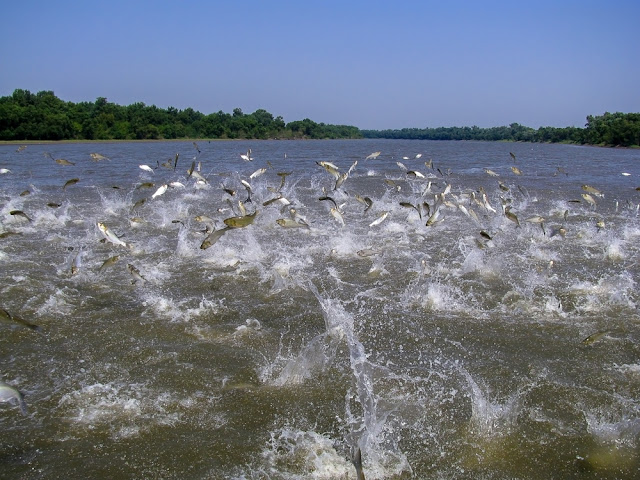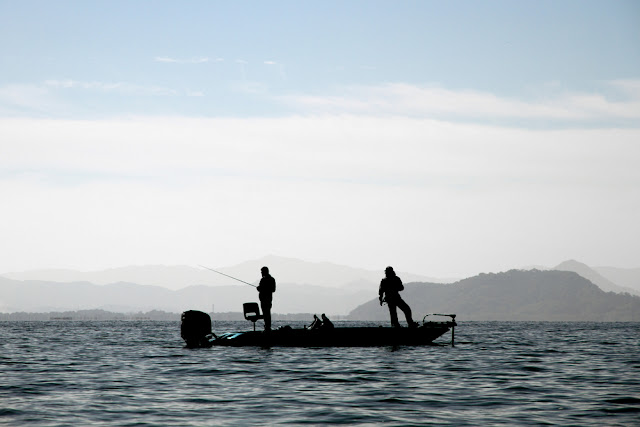Area 51 in Our Own Backyard?
There is an alien invasion going on all around us! Now these aren’t the aliens that you see in the movies, but they are certainly just as scary if you enjoy spending time on the water. Asian Carp pose a great threat to our waterways here in in the United States, and are knocking on our backdoor here at the Lake of the Ozarks.
What Are Asian Carp?
Big Head, Silver, Black, and Grass Carp are all collectively known as Asian Carp, with the most prolific being Big Head and Silver Carp. They were introduced to the U.S. in the 1970’s to control
plankton and other nuisance populations in southern ponds. Flooding allowed these fish to escape their confined ponds and make their way into the Mississippi River. These non-native invaders have since been able to bulldoze their way up the Mississippi river. According to a 2013 study by the US Fish and Wildlife Service, they can now be found in over 23 state’s waterways.
Why Are They a Problem?
Asian Carp are a non-native species, with Blue/Flat Head Catfish and Alligator Gar as the only known predators that will consume them. They are also very prolific, capable of laying hundreds of
thousands of eggs multiple times a year. Because of this, they are able to take over a large portion of the biomass of the ecosystem they invade. They are a fast growing fish that can measure over 4ft
long and weigh in at well over 100 lbs. Because they can consume up to 40% of their body weight every day, they may outcompete native species for plankton, an organism at the base of the food chain.
In addition to the threat to the ecosystem, they also pose a huge problem for aquatic tourism. Silver Carp are known to group up into massive schools, and will often jump up to 8 ft out of the water once spooked by a boat. This is both dangerous and highly discouraging to recreational boaters and fisherman.
Are Asian Carp in the Lake of the Ozarks?
According to MDC Lake of the Ozarks Fishing Biologist Greg Stoner, they have found a small number of Asian Carp in the Lake “We did have a couple of Big Head Carp show up this year, but they have been in the 70 lb range. The last one that showed up prior to that was in 2011, and it weighed 106 lbs, so it is feasible that those fish could be from the same year class. If we were to find a 5lb fish, then I would be concerned. That would mean that there is some reproduction going on. As variable as fish growth can be, it is very plausible that the 70 lbrs and 106 lb fish were all the same age.” When asked about Asian Carp’s capabilities to reproduce in the Lake of the Ozarks, Stoner went on to add, “Truman dam is actually a barrier that helps prevent a mass reproduction event.
They need a very long expanse of open and free flowing water for their eggs to develop, and we don’t typically have those conditions. However, there is some concern for if they were to get into Truman Lake, since it has a long expanse of free flowing water coming from all the way up into Kansas.”
What Are Some Ways to Help Prevent Them from Spreading?
 Since we have Bagnell Dam as a barrier, and they don’t have a lock to swim through, the only way carp can make it into our lake is through human hands. Stoner adds, “The best thing we can do is educate the public, and a lot of it has to do with bait. We know that there are Asian Carp in the Osage River. If you look at a three-inch-long Silver Carp, Bighead Carp, and Gizzard shad, they will all look the same. Since it is so hard to tell the difference, you should NEVER transfer bait from one body of water to another.
Since we have Bagnell Dam as a barrier, and they don’t have a lock to swim through, the only way carp can make it into our lake is through human hands. Stoner adds, “The best thing we can do is educate the public, and a lot of it has to do with bait. We know that there are Asian Carp in the Osage River. If you look at a three-inch-long Silver Carp, Bighead Carp, and Gizzard shad, they will all look the same. Since it is so hard to tell the difference, you should NEVER transfer bait from one body of water to another.
What Are Asian Carp?
Big Head, Silver, Black, and Grass Carp are all collectively known as Asian Carp, with the most prolific being Big Head and Silver Carp. They were introduced to the U.S. in the 1970’s to control
plankton and other nuisance populations in southern ponds. Flooding allowed these fish to escape their confined ponds and make their way into the Mississippi River. These non-native invaders have since been able to bulldoze their way up the Mississippi river. According to a 2013 study by the US Fish and Wildlife Service, they can now be found in over 23 state’s waterways.
Why Are They a Problem?
Asian Carp are a non-native species, with Blue/Flat Head Catfish and Alligator Gar as the only known predators that will consume them. They are also very prolific, capable of laying hundreds of
thousands of eggs multiple times a year. Because of this, they are able to take over a large portion of the biomass of the ecosystem they invade. They are a fast growing fish that can measure over 4ft
long and weigh in at well over 100 lbs. Because they can consume up to 40% of their body weight every day, they may outcompete native species for plankton, an organism at the base of the food chain.
In addition to the threat to the ecosystem, they also pose a huge problem for aquatic tourism. Silver Carp are known to group up into massive schools, and will often jump up to 8 ft out of the water once spooked by a boat. This is both dangerous and highly discouraging to recreational boaters and fisherman.
Are Asian Carp in the Lake of the Ozarks?
According to MDC Lake of the Ozarks Fishing Biologist Greg Stoner, they have found a small number of Asian Carp in the Lake “We did have a couple of Big Head Carp show up this year, but they have been in the 70 lb range. The last one that showed up prior to that was in 2011, and it weighed 106 lbs, so it is feasible that those fish could be from the same year class. If we were to find a 5lb fish, then I would be concerned. That would mean that there is some reproduction going on. As variable as fish growth can be, it is very plausible that the 70 lbrs and 106 lb fish were all the same age.” When asked about Asian Carp’s capabilities to reproduce in the Lake of the Ozarks, Stoner went on to add, “Truman dam is actually a barrier that helps prevent a mass reproduction event.
They need a very long expanse of open and free flowing water for their eggs to develop, and we don’t typically have those conditions. However, there is some concern for if they were to get into Truman Lake, since it has a long expanse of free flowing water coming from all the way up into Kansas.”
What Are Some Ways to Help Prevent Them from Spreading?
 Since we have Bagnell Dam as a barrier, and they don’t have a lock to swim through, the only way carp can make it into our lake is through human hands. Stoner adds, “The best thing we can do is educate the public, and a lot of it has to do with bait. We know that there are Asian Carp in the Osage River. If you look at a three-inch-long Silver Carp, Bighead Carp, and Gizzard shad, they will all look the same. Since it is so hard to tell the difference, you should NEVER transfer bait from one body of water to another.
Since we have Bagnell Dam as a barrier, and they don’t have a lock to swim through, the only way carp can make it into our lake is through human hands. Stoner adds, “The best thing we can do is educate the public, and a lot of it has to do with bait. We know that there are Asian Carp in the Osage River. If you look at a three-inch-long Silver Carp, Bighead Carp, and Gizzard shad, they will all look the same. Since it is so hard to tell the difference, you should NEVER transfer bait from one body of water to another.
Like What You See?
If you've enjoyed reading this article today, check out more by joining Bassing Bob today! You can also find this and many other great reads by visiting your local grocer and picking up a copy of our Fishing Magazine!
If you fish at the Lake of the Ozarks, or anywhere else for that matter, and you aren’t a member at BassingBob.com yet, you're missing out on some super sweet benefits. Worried about cost? Don't be! With different levels of memberships, we make our memberships as economical as possible by enabling members to subscribe to the platforms that cover their interests. When it comes to one source of information for bass fishing, Bassing Bob is it!
If you fish at the Lake of the Ozarks, or anywhere else for that matter, and you aren’t a member at BassingBob.com yet, you're missing out on some super sweet benefits. Worried about cost? Don't be! With different levels of memberships, we make our memberships as economical as possible by enabling members to subscribe to the platforms that cover their interests. When it comes to one source of information for bass fishing, Bassing Bob is it!







Comments
Post a Comment